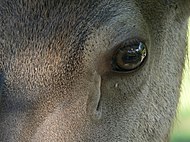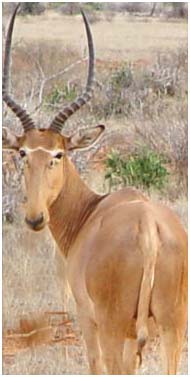Preorbital gland
| Preorbital gland | |
|---|---|
 | |
 | |
| Details | |
| Artery | lacrimal artery |
| Nerve | lacrimal nerve, Zygomatic nerve via Communicating branch, greater petrosal nerve |
| Identifiers | |
| Latin | glandula praeorbitalis |
| Anatomical terminology | |
The preorbital gland is a paired
The preorbital gland serves different roles in different species. Pheromone-containing secretions from the preorbital gland may serve to establish an animal's
In cervids

North American deer
The two major species of deer found in
The preorbital gland of O. virginianus is about 22 millimeters (0.87 in) in length, while that of O. hemionus is roughly 40 millimeters (1.6 in) in length. In black-tailed deer (O. h. columbianus), a subspecies of O. hemionus, the preorbital gland measures about 32 millimeters (1.3 in).[1] In all of these animals, the preorbital glands are surrounded by muscle which is under voluntary control, at least to some extent.[8]
It is not entirely clear whether the preorbital gland secretions of North American deer are significant for chemical communication. Most of the time the glands remain closed, but deer are capable of opening them to emit an odor in certain circumstances. For example, a rutting male may dilate its preorbital glands in order to signal aggression to another nearby male. Female deer often open their glands while caring for their young.[8]
Other deer
In juvenile red deer (Cervus elaphus), the preorbital gland appears to play a role in the response to stress. The preorbital gland is closed in a relaxed calf, whereas it is opened in a stressed calf.[10] One example of this is the signalling of hunger and satiety. Fawns open their preorbital glands as a signal that they are hungry, and close the gland after feeding, when they are no longer hungry.[11]
The adult
In bovids

The
The antilopine bovids (dwarf antelope, such as the springbok, blackbuck, gazelles, dik-diks, oribi, and several similar species) have well-developed preorbital glands.[3]
Among the cephalophines, members of the Philantomba and Sylvicapra genera are all solitary animals which display territorial behavior and have well developed preorbital glands. Maxwell's duiker (Philantomba maxwellii) is a solitary animal which utilizes preorbital gland secretions to mark its territory. This behavior is observed most in adult males, less frequently in females, and less still in subadults of this species.[16] Secretions from the preorbital gland of the common duiker contain at least 33 different chemical compounds. Two thiazole compounds and an epoxy ketone are present in significantly higher concentrations in male than in female secretions, suggesting that they could serve as sex recognition cues.[17]
The alcephine bovids (wildebeests, hartebeests, hirola, bontebok, blesbok, and several similar species) have preorbital glands which secrete complex mixtures of chemical compounds.[3] The preorbital glands of the bontebok (Damaliscus pygargus pygarus) are larger in males than in females. Their secretions contain at least forty different chemical compounds, and are deposited on grass and twigs at the borders of their territory. They then appear to transfer the secretions from the grass to their horns and forehead by waving the head from side to side across the stalk bearing the secretion. Marking of plant stalks with preorbital gland secretions is seen in both sexes.[18] In contrast to the duikers and raphicerids, the klipspringer (Oreotragus oreotragus) is a semi-gregarious species, while the hirola (Beatragus hunteri) is fully gregarious. Nevertheless, these animals display territorial scent marking of grasses with secretions from their preorbital glands.[16][19]
Differences in the social structure and marking behavior among different species may lead to a different size and position of the preorbital glands on the animal's face. For example,
Research directions
The recent identification of several antimicrobial compounds from the secretions of animal dermal scent glands may be the beginning of a promising new area of drug development. Assuming functional analogs of these lead compounds can be synthesized and found to be effective in vivo, the potential exists for producing new antimicrobial agents against pathogenic skin microorganisms.[6]
See also
- Deer musk
- Supraorbital gland
Footnotes
- ^ ISBN 1-59228-465-5.
- ISBN 978-0471102533.
- ^ ISSN 0340-1022.
- JSTOR 2425092?.
- ^ a b "Understanding deer glands". Huntley, Illinois: Hunting Network, LLC. 2012. Retrieved 2012-05-21.
- ^ PMID 21179314.
- ^ Nickens, TE (2009-11-05). "Understanding seven deer glands". Field & Stream Online. New York: Field & Stream. Retrieved 2012-05-27.
- ^ a b c Miller, KV (1990). "Deer scent communication: what do we really know?" (PDF). Deer Hunters News. 10: 21–2. Archived from the original (PDF) on 2013-01-26.
- doi:10.1644/871.1.
- PMID 17040951.[permanent dead link]
- PMID 15583051.[permanent dead link]
- ^ Eisenberg, JF; McKay, GM (1974). "Comparison of ungulate adaptations in the new world and the old world tropical forests with special reference to Ceylon and the rainforests of Central America". In Geist, V; Walther, F (eds.). The behaviour of ungulates and its relation to management (PDF). Morges, Switzerland: International Union for Conservation of Nature and Natural Resources. pp. 584–602.
- ISBN 978-0-470-28558-9.
- ^ Bergerud, AT (1974). "Management of ungulate herds in relation to domestication". In Geist, V; Walther, F (eds.). The role of the environment in the aggregation, movement and disturbance behaviour of caribou (PDF). Morges, Switzerland: International Union for Conservation of Nature and Natural Resources. pp. 552–84.
- ^ Baskin, LM (1974). "Management of ungulate herds in relation to domestication". In Geist, V; Walther, F (eds.). The behaviour of ungulates and its relation to management (PDF). Morges, Switzerland: International Union for Conservation of Nature and Natural Resources. pp. 530–41.
- ^ a b Bigalke, RC (1974). "Ungulate behaviour and management, with special reference to husbandry of wild ungulates on South African ranches". In Geist, V; Walther, F (eds.). The behaviour of ungulates and its relation to management (PDF). Morges, Switzerland: International Union for Conservation of Nature and Natural Resources. pp. 830–52.
- S2CID 42031611.
- ^ Huffman, B (2004-03-22). "Damaliscus pygargus". Order Cetartiodactyla. Ultimateungulate.com. Retrieved 2012-05-21.
- ^ Huffman, B (2008-12-31). "Beatragus hunteri". Order Cetartiodactyla. Ultimateungulate.com. Retrieved 2012-05-21.
- ^ Frey, R; Hofmann, RR (1997). "Skull, proboscis musculature and preorbital gland in the saiga antelope and Guenther's dikdik (Mammalia, Artiodactyla, Bovidae)". Zoologischer Anzeiger. 235 (3–4): 183–99. Archived from the original on 2013-01-28.
Further reading
- Ainoya, JRM (1978). "Histological aspects of the preorbital and interdigital glands of the red duiker (Cephalophus natalensis)". African Journal of Ecology. 16 (4): 265–72. .
- Gray, DR; Flood, PF; Rowell, JE (1989). "The structure and function of muskox preorbital glands". Canadian Journal of Zoology. 67 (5): 1134–42. doi:10.1139/z89-163.
- Rajagopal, T; Manimozhi, A; Archunan, G (2011). "Diurnal variation in preorbital gland scent marking behaviour of captive male Indian Blackbuck (Antelope cervicapra L.) and its territorial significance". Biological Rhythm Research. 42 (1): 27–38. S2CID 84513333.
- Rajagopal, T; Archunan, G (2011). "Histomorphology of preorbital gland in territorial and non-territorial male blackbuck Antelope cervicapra, a critically endangered species". Biologia. 66 (2): 370–8. S2CID 207392635.
- Vrba, ES; Schaller, GB (2000). "Phylogeny of Bovidae based on behavior, glands, skulls, and postcrania". In Vrba, ES; Schaller, GB (eds.). Antelopes, deer, and relatives. New Haven, Connecticut: Yale University Press. pp. 203–22. ISBN 0-300-08142-1.
- Wilkinson, PF (1974). "Behaviour and domestication of the musk ox". In Geist, V; Walther, F (eds.). The behaviour of ungulates and its relation to management (PDF). Morges, Switzerland: International Union for Conservation of Nature and Natural Resources. pp. 909–20.
